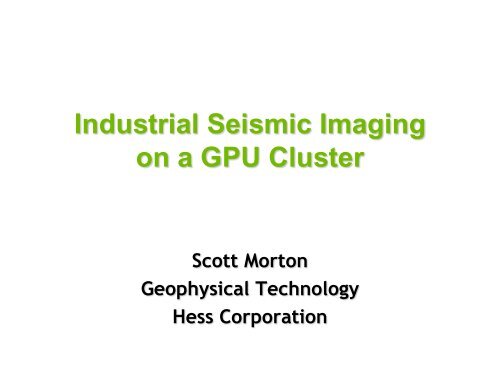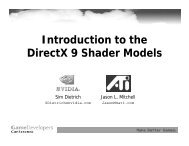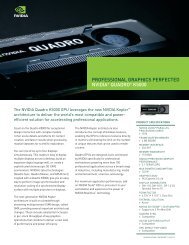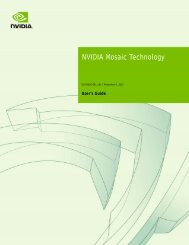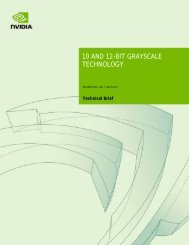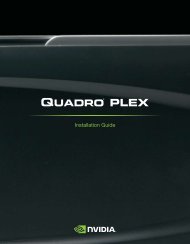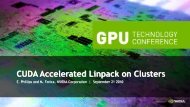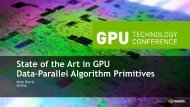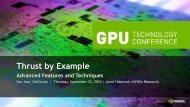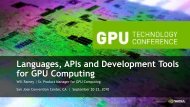Download PDF - Nvidia
Download PDF - Nvidia
Download PDF - Nvidia
Create successful ePaper yourself
Turn your PDF publications into a flip-book with our unique Google optimized e-Paper software.
Industrial Seismic Imaging<br />
on a GPU Cluster<br />
Scott Morton<br />
Geophysical Technology<br />
Hess Corporation
Seismic Imaging<br />
Outline<br />
• Industrial seismic data & imaging<br />
– Why use GPUs?<br />
• Computational approach<br />
– Job decomposition & break-up<br />
– Hierarchical batch job submission & control<br />
– GPU programming<br />
• Production codes<br />
– Performance<br />
– Multi-GPU issues & results<br />
• Growth of a GPU cluster<br />
• Summary of GPU usage<br />
2
Seismic Imaging<br />
Data<br />
gas<br />
oil<br />
H 2 O<br />
3
Seismic Imaging<br />
Data<br />
Receiver<br />
Time (ms)<br />
4
Seismic Imaging<br />
Data<br />
5
Seismic Imaging<br />
An iterative process<br />
Construct initial<br />
earth model<br />
Computation scales<br />
as size of data and<br />
image/model<br />
Perform imaging<br />
Update earth model<br />
Redundant<br />
images selfconsistent?<br />
No<br />
Done<br />
Yes<br />
6
Seismic Imaging<br />
Computational kernel<br />
Source s<br />
Receiver r<br />
y<br />
x<br />
T S<br />
z<br />
T R<br />
t = T S + T R<br />
Add to<br />
Image<br />
Image point x<br />
1 migration<br />
contribution<br />
<br />
I(<br />
x)<br />
Data trace<br />
<br />
<br />
<br />
s,<br />
r<br />
D<br />
<br />
<br />
s,<br />
r,<br />
t<br />
<br />
Image<br />
trace<br />
<br />
T( s,<br />
x)<br />
<br />
<br />
T( x,<br />
r)<br />
<br />
7
Seismic Imaging<br />
Computational scale<br />
• Imaging integral formulation:<br />
<br />
2 2 <br />
O( x)<br />
d xs<br />
d xR<br />
A( x,<br />
xs,<br />
xR)<br />
Ixs<br />
, xR,<br />
t T( x,<br />
xs)<br />
T( x,<br />
x<br />
– 4-D <br />
<br />
surface integral through a 5-D data set<br />
• Computational complexity:<br />
– N O ~ 10 9 is the number of output image points<br />
– N I ~ 10 8 is the number of input data traces<br />
– f ~ 30 is the number of cycles/point/trace<br />
– f N O N I ~ 3 x 10 18 cycles ~ 30 cpu-years<br />
R<br />
) <br />
8
Seismic Imaging<br />
Theory<br />
9
Seismic Imaging<br />
Theory<br />
10
Seismic Imaging<br />
Why GPUs?<br />
• Price-to-performance ratio improvement<br />
– Want 10X to change platforms<br />
• Payback must more than cover effort & risk<br />
• Got 10X ten years ago in switching from<br />
supercomputers to PC clusters<br />
11
Seismic Imaging<br />
Why GPUs?<br />
• Price-to-performance ratio improvement<br />
– Want 10X to change platforms<br />
• Payback must more than cover effort & risk<br />
• Got 10X ten years ago in switching from<br />
supercomputers to PC clusters<br />
– Several years ago there were indicators<br />
we can get 10X or more on GPUs<br />
• Peak performance<br />
• Benchmarks<br />
• Simple prototype kernels<br />
12
Seismic Imaging<br />
Parallel algorithms<br />
• Highly parallelizable<br />
– small kernel, inside large set of loops<br />
– computation dominates communication<br />
• t IO ~ 1 day
Seismic Imaging<br />
Hierarchical batch jobs<br />
• Two levels of batch job handling<br />
– Top level is home-grown job handler<br />
• Submit full imaging jobs<br />
– Brazil, Gulf of Mexico, Indonesia, …<br />
• Handles job steps<br />
– Distribute data<br />
– Pre-compute times of propagation<br />
– Break-up image region<br />
– Compute image pieces<br />
– Collect & sum image pieces<br />
– …<br />
• Each step may contain many tasks<br />
14
Seismic Imaging<br />
Hierarchical batch jobs<br />
• Two levels of batch job handling<br />
– Use Sun Grid Engine (SGE) to handle<br />
arrays of tasks<br />
• Number of CPUs and GPUs per node are<br />
specified as SGE resources<br />
• Each task requires a specific set of resources<br />
• Linux OS handles CPU processes<br />
• NVIDIA driver handles GPU allocation<br />
– We use GPUs in “exclusive” mode,<br />
meaning only 1 process can use a given GPU<br />
15
GPU Programming<br />
Approach<br />
• Design the computational algorithm just as<br />
you would with any parallel machine<br />
– Understand memory hierarchy<br />
• Size at each level<br />
• access characteristics<br />
• Bandwidth between levels<br />
– Stage data to computational engines efficiently<br />
16
GPU Programming<br />
Heuristics<br />
• Thread & block indices are analogs of loop<br />
indices<br />
– Use the CPU as a controller and data stager<br />
• Keep the CPU out of the loops as much as possible<br />
• Keep main data structures in GPU memory<br />
• Use as few GPUs per task as possible<br />
• Rarely efficient to loop over streaming data from CPU<br />
– Work for a thread is generally a single inner loop<br />
17
GPU Programming<br />
How to port a code?<br />
• Create prototype GPU kernel<br />
– Include main computational characteristics<br />
– Test performance against CPU kernel<br />
– Iteratively refine prototype<br />
• Port full kernels & compare with CPU results<br />
– Verify numerically<br />
– Compare performance<br />
• Incorporate into production code & system<br />
18
GPU Programming<br />
Production codes<br />
• 2 of our 3 production codes<br />
– Use 1 GPU per task<br />
– Have exactly 1 loop per thread<br />
• All 3 production codes<br />
– Have at least 1 loop per thread<br />
– Use 1 CPU to control 1 GPU<br />
– Use only the GPUs on a single node<br />
• For more algorithmic details,<br />
see my talk at<br />
– http://hpcoilgas.citris-uc.org/<br />
19
Billions of Migration Contributions per Second.<br />
Kirchhoff Imaging<br />
Kernel optimization<br />
10.00<br />
9.00<br />
8.00<br />
7.00<br />
6.00<br />
5.00<br />
4.00<br />
3.00<br />
2.00<br />
Performance<br />
GPU<br />
CPU<br />
0 – Initial Kernel<br />
1 – Used Texture Memory<br />
2 – Used Shared Memory<br />
3 – Global Memory Coalescing<br />
4 – Decreased Data Trace Shared<br />
Memory Use<br />
5 – Optimized Use of Shared<br />
Memory<br />
6 – Consolidated “if” Statements,<br />
Eliminated or Substituted Some<br />
Math Operations<br />
7 – Removed an “if” and “for”<br />
8 – Used Texture Memory for Data-<br />
Trace Fetch<br />
1.00<br />
0.00<br />
0 1 2 3 4 5 6 7 8 9<br />
Code Version<br />
20
GPU Speed-up<br />
Kirchhoff Imaging<br />
Kernel performance<br />
GPU-to-CPU Performance Ratio<br />
100<br />
Typical parameter range<br />
GT200<br />
80<br />
60<br />
40<br />
20<br />
CUDA 2D Tex (nix=4)<br />
CUDA Linear Tex (nix=4)<br />
CUDA 2D Tex (niy=4)<br />
CUDA Linear Tex (niy=4)<br />
CUDA 2D Tex (nix=4) G2<br />
CUDA 2D Tex (nix=4) G2 PIN<br />
CUDA Linear Tex (nix=4) G2<br />
CUDA Linear Tex (nix=4) G2 PIN<br />
CUDA 2D Tex (niy=4) G2<br />
CUDA 2D Tex (niy=4) G2 PIN<br />
CUDA Linear Tex (niy=4) G2<br />
CUDA Linear Tex (niy=4) G2 PIN<br />
G80<br />
0<br />
2 4 6 8 10 12 14 16 18<br />
image points per travel-time cell in x or y<br />
21
Kirchhoff Imaging<br />
Production status<br />
• GPU kernel incorporated into production code<br />
– Large kernel speed-ups results in task‟s “CPU overhead”<br />
dominating GPU production runs<br />
• Further optimizations<br />
– create GPU kernels for most “overhead” components<br />
– optimized left-over CPU code (which helps CPU version also)<br />
Time (hr) Set-up Kernel Total Speed-up<br />
Original CPU code 5 20 25<br />
Main GPU kernel 5 0.5 5.5 5<br />
Further<br />
optimizations<br />
0.5 0.5 1 25<br />
22
Speedup<br />
“Reverse-time” Imaging<br />
Kernel performance<br />
8th order, RTM<br />
30<br />
25<br />
20<br />
15<br />
10<br />
5<br />
0<br />
128x128x200<br />
256x96x200<br />
96x256x200<br />
256x256x200<br />
480x480x200<br />
512x512x512<br />
Grid size<br />
640x640x200<br />
960x704x200<br />
704x960x200<br />
const, 16x16<br />
shared, 16x16<br />
const, 16x32<br />
shared, 16x32<br />
23
“Reverse-time” Imaging<br />
Inter-GPU communication<br />
• High frequency requires<br />
– Dense sampling<br />
– Large memory<br />
– Multiple GPUs<br />
– Halo exchange<br />
– Inter-GPU communication<br />
• Device Host<br />
– Use pinned memory<br />
– PCIe bus predictably yields ~ 5 GB/s<br />
– ~ 10 % of kernel time<br />
– Easily hidden<br />
24
“Reverse-time” Imaging<br />
Inter-GPU communication<br />
• CPU process process<br />
– Currently using MPI<br />
• From legacy code<br />
– Performance variable<br />
– Comparable to kernel time<br />
– Solutions<br />
• OpenMP?<br />
• single controlling process?<br />
• Node node<br />
– Currently Gigabit Ethernet<br />
– Moving to 10 Gigabit Ethernet<br />
25
Multi-GPU Performance<br />
using MPI<br />
26
Multi-GPU Performance<br />
Using MPI+OpenMP<br />
27
Hess GPU Cluster<br />
• Got a single-card test system in spring „07<br />
– Used for prototyping Kirchhoff code<br />
– Benchmarked simple kernels<br />
28
Hess GPU Cluster<br />
• Got 32-node system in Dec ‟07<br />
– Each node contains<br />
• Dual quad-core 1U server with 8 GB memory<br />
• Connected to 1U 4-GPU server with 1.5 GB each<br />
– Running test codes by end of Feb „08<br />
– Started production testing in May „08<br />
– 2 seismic imaging codes in production in summer ‟08<br />
29
Hess GPU Cluster<br />
• 2 nd generation system in Dec ‟08<br />
– Upgraded to 4 GB, 2 nd generation GPUs<br />
– Upgraded to 32 GBs on each CPU server<br />
– Added 82 more nodes to make 114 total<br />
30
Hess GPU Cluster<br />
• 2 nd generation system in Dec ‟08<br />
– Upgraded to 4 GB, 2 nd generation GPUs<br />
– Upgraded to 32 GBs on each CPU server<br />
– Added 82 more nodes to make 114 total<br />
• Upgraded Nov ‟09<br />
– Retired 500 non-GPU nodes<br />
– Added 186 more GPU nodes<br />
– For a total of 1200 GPUs<br />
• Most of our compute power in GPUs<br />
• Upgrading Nov ‟10<br />
– Details being determined ….<br />
31
GPU adoption<br />
Where on the S-Curve are we?<br />
Hardware<br />
“Wave-eqn” imaging<br />
Kirchhoff imaging<br />
“Reverse-time” imaging<br />
time<br />
32
Acknowledgements<br />
• Code co-authors/collaborators<br />
– Thomas Cullison (Hess & Colorado School of Mines)<br />
– Paulius Micikevicius (NVIDIA)<br />
– Igor Terentyev (Hess & Rice University)<br />
• Hess GPU systems<br />
– Jeff Davis, Mac McCalla, Gary Whittle<br />
• NVIDIA support & management<br />
– Ty Mckercher, Paul Holzhauer<br />
• Hess management<br />
– Jacques Leveille, Vic Forsyth, Jim Sherman<br />
33


